Recently there has been a lot of debate about whether you actually need hiking boots. Some “experts” say that hiking boots are overhyped and that lightweight trail running shoes are better. And then there are all those people who successfully hike in sneakers.
So, do you really need to wear hiking boots or are regular shoes fine?
The short answer:
You don’t need boots when hiking on easy terrain, smooth trails and dry conditions. Trail runners, sneakers or even certain sandals should be fine. However, hiking boots or hiking shoes are absolutely necessary whenever you are going on rougher, technical terrain with scree, creek crossings or lots of mud. In these conditions, sneakers or trail runners could result in injury – which is why search and rescue teams caution hikers to wear boots. It’s also why forest rangers, firefighters and soldiers wear boots instead of shoes.
The Arguments Against Hiking Boots
Lately it has become trendy for ultralight thru-hikers to wear trail runner shoes instead of hiking boots. They make some good argumenst against boots — but these arguments only hold up in certain situations. For example, they will argue that:
Boots Are Heavy:
Yes, heavy boots will cause your legs to become fatigued as quickly. Some then take this argument further by claiming that you are less likely to become injured since you won’t be as tired.
However, hiking boots aren’t as heavy as they used to be. Since they give you support, your legs might end up less tired on uneven terrain.
Blisters:
Because boots don’t flex as much and your feet get sweaty in them, they are more likely to cause blisters than a lightweight shoe.
But blisters are easy to solve by wearing two pairs of socks so sweat is wicked away and your skin isn’t rubbed. And you can get blisters hiking in lightweight, flexible shoes too — especially if the shoes get wet. Because they don’t lace up as high, feet tend to slide around in wet sneakers and shoes. Sneakers are also like sponges that hold water, creating the perfect conditions for blisters.
Boots Take forever to dry:
No boot is really waterproof and they will take a long time to dry when wet. By contrast, a lightweight trail runner will dry out quickly.
But, again, this argument only holds up if you are hiking in warm, dry conditions. Not even trail runners will dry out in wet conditions! And the argument overlooks the fact that hiking in wet boots isn’t actually so terrible. By contrast, hiking in wet shoes is nasty. Your feet slide around in them and water doesn’t get wicked away from your skin.
Expensive:
A good pair of hiking boots is expensive, which is why some people just wear their sneakers instead. But this argument doesn’t factor in the cost of destroyed shoes. Sneakers and trail runners aren’t designed to handle tough conditions. They fall apart quickly. By contrast, I bought a pair of boots in 2003 for $150 and, even after thousands of miles of use in wet, snowy conditions, they are still fine (I did get them patched twice).
Reasons to Wear Hiking Boots
1. Boots Really Do Provide Ankle Support
A lot of the trail runner advocates will tell you that “ankle support is a myth.” While it is true that there are few actual studies about whether boots prevent ankle injuries, it doesn’t mean that boots don’t help.
In this study, for example, high-top shoes significantly reduce the amount of ankle inversion compared to low-top shoes. The researchers concluded that high-top shoes may also prevent ankle sprains when carrying heavy loads. And this study found that boots reduced ankle inversion angles by 3.6 degrees in motorcycle drops.
Research in the Sports Medicine found that, “Studies support the use of high top shoes for ankle sprain prevention because of their ability to limit extreme ranges of motion, provide additional proprioceptive input and decrease external joint stress.”

Boots help keep you safe on wet, slippery ground like this trail in Oregon.
2. Hard Sole with Good Traction
Boots have thick, hard soles with lots of traction. These are absolutely necessary when you are hiking on loose stones or shale. The soft sole of trail runners or sneakers will bend, preventing you from getting good traction. By contrast, you can dig the sole of the boot in to get better footing.
Those thick soles also make some hikes much more comfortable. As one hiker said of hiking in her Merrell shoes on a trail full of rocks, “I could feel most rocks through the sole.”
3. Slough Off Mud
Hiking boots do a good job of sloughing off mud. By contrast, mud will build up around most regular shoes. They will get heavier and slippery with each step you take.
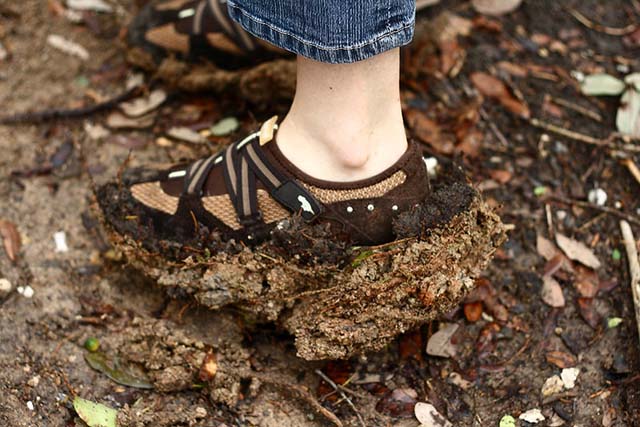
“Walking on the trail was hampered by having to stop every few minutes and shake off the caked mud.”
4. Snake Bites
Snake bites rarely occur above the ankle. Because of this, wearing high-top hiking boots could prevent you from getting bit by a snake. I wouldn’t rely on boots alone to protect me (you should be vigilant about checking where you step in snake territory), but it does give me some peace of mind.
When You Can Get Away with Wearing Shoes Instead of Boots
On trails with dry grass or smooth rock or compacted ground, you don’t need boots. This includes the Pacific Crest Trail, Colorado, and Arizona. If you are new to hiking and aren’t sure whether you want to invest in good boots yet, then go on a very easy hike in your shoes. If you struggle with the easy hike, then you will definitely need some boots before you attempt anything more difficult.
What’s your take on this — do you wear boots or shoes when hiking? Let us know in the comments below.
Image credits:
“Take a Break” (CC BY-NC 2.0) by hugoccampos,
“Muddy much?” (CC BY-NC 2.0) by arsheffield,
“Roots and Boots. Forest Park – Upper M” (CC BY-NC-SA 2.0) by Terry.Tyson,
“Signal Knob – Prune Feet (Cropped)” (CC BY-NC-SA 2.0) by Vicky TGAW,
“The aftermath” (CC BY-NC-SA 2.0) by CrashSensei,
“cutting the bottoms off of my shoes” (CC BY-NC 2.0) by tango.mceffrie,


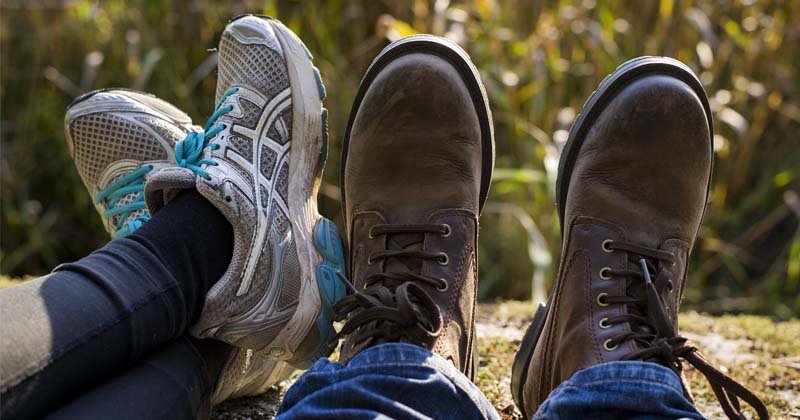
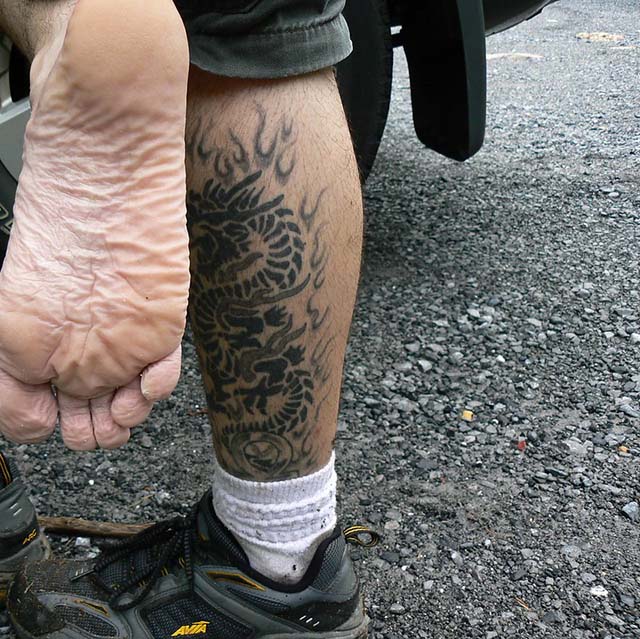
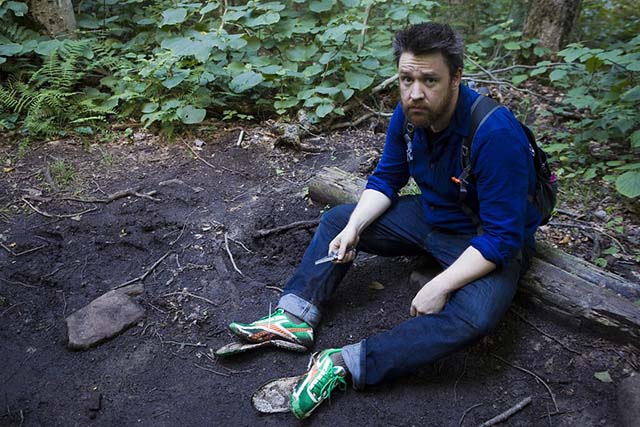
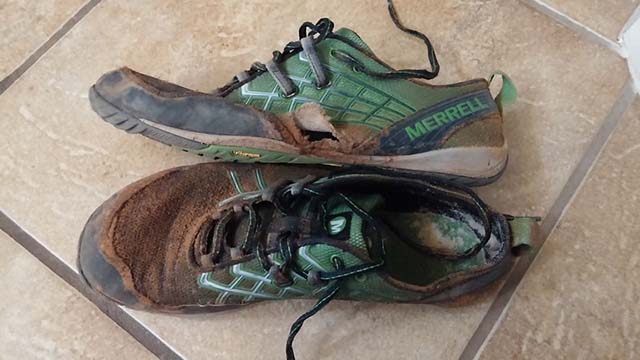

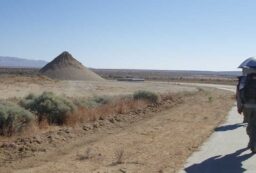








Post your comments